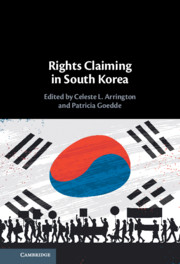Book contents
- Rights Claiming in South Korea
- Rights Claiming in South Korea
- Copyright page
- Dedication
- Contents
- Contributors
- Acknowledgments
- Abbreviations
- Introduction Rights in Action
- Part I Rights in Historical Perspective
- Part II Institutional Mechanisms for Rights Claiming
- 4 A Clash of Claims
- 5 Advancing Human Rights, Advancing a Nation
- 6 The Constitutional Court as a Facilitator of Fundamental Rights Claiming in South Korea, 1988–2018
- 7 Rights Claiming through the Courts
- 8 Public Interest Lawyering in South Korea
- Part III Mobilizing Rights for the Marginalized
- Part IV Shaping Rights for New Citizens and Noncitizens
- Conclusion Findings and Future Directions
- Index
- References
4 - A Clash of Claims
The Diversity and Effectiveness of Rights Claims around the Jeju 4.3 Events
from Part II - Institutional Mechanisms for Rights Claiming
Published online by Cambridge University Press: 17 April 2021
- Rights Claiming in South Korea
- Rights Claiming in South Korea
- Copyright page
- Dedication
- Contents
- Contributors
- Acknowledgments
- Abbreviations
- Introduction Rights in Action
- Part I Rights in Historical Perspective
- Part II Institutional Mechanisms for Rights Claiming
- 4 A Clash of Claims
- 5 Advancing Human Rights, Advancing a Nation
- 6 The Constitutional Court as a Facilitator of Fundamental Rights Claiming in South Korea, 1988–2018
- 7 Rights Claiming through the Courts
- 8 Public Interest Lawyering in South Korea
- Part III Mobilizing Rights for the Marginalized
- Part IV Shaping Rights for New Citizens and Noncitizens
- Conclusion Findings and Future Directions
- Index
- References
Summary
This chapter examines the complexity of rights-claiming in South Korea related to the violence on Jeju Island around April 3, 1948. The Jeju case demonstrates that rights claiming and counterclaiming over seventy years shaped the transitional justice process, which can be divided into four distinct periods according to the nature and dynamics of rights claims and counterclaims. I find that rights claims by both sides were not made in a vacuum but within a thick layer of existing discourses and narratives, colored by existing power structures. Over the decades, interesting dynamics of claim diversification and frame resonance occurred depending on the opportunity structures in a particular time and space. I found that rights claims diversify when the counterclaims are strong and the opportunity structure opens up. In addition, frame resonance influences the effectiveness of rights claims.
Keywords
- Type
- Chapter
- Information
- Rights Claiming in South Korea , pp. 85 - 105Publisher: Cambridge University PressPrint publication year: 2021

